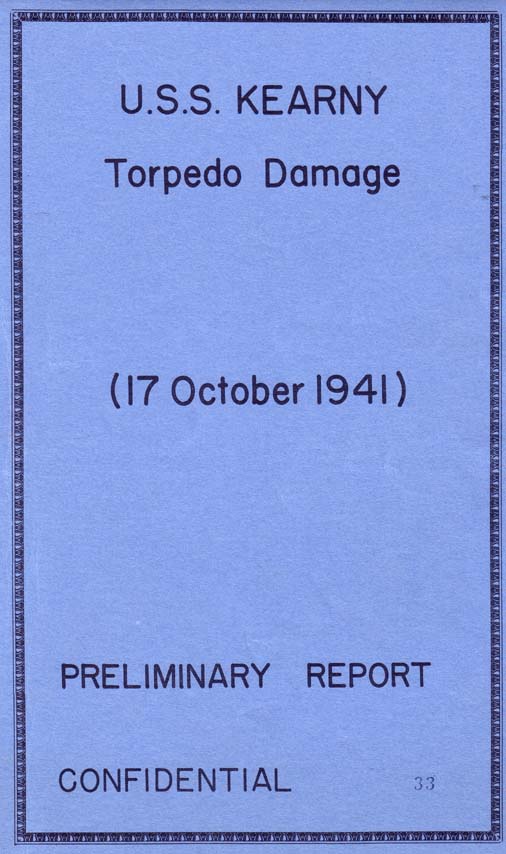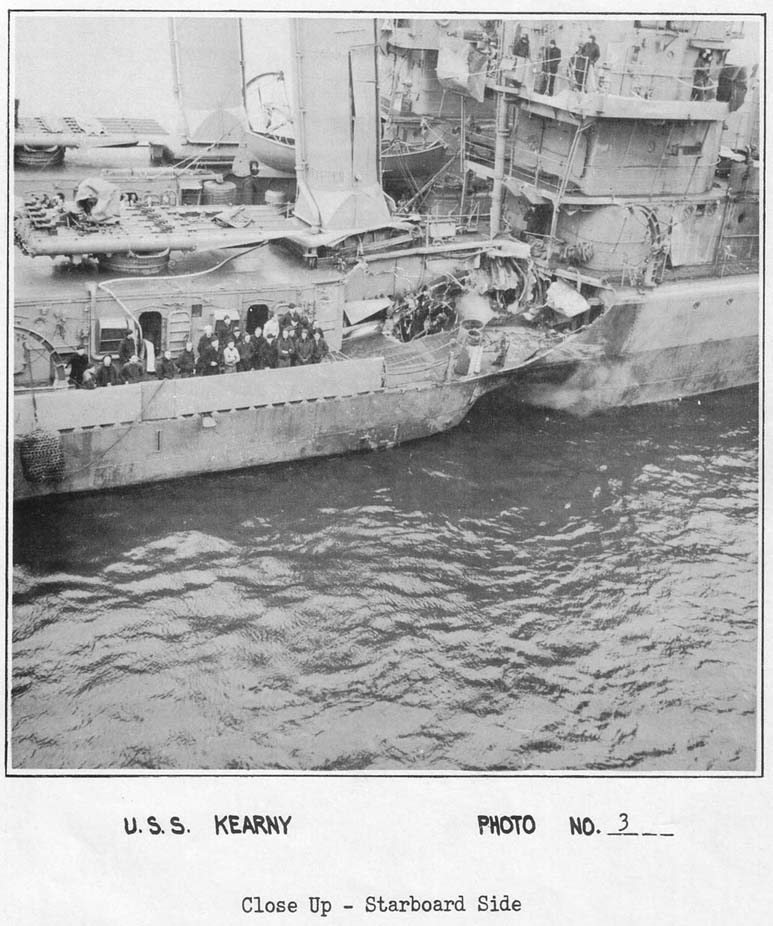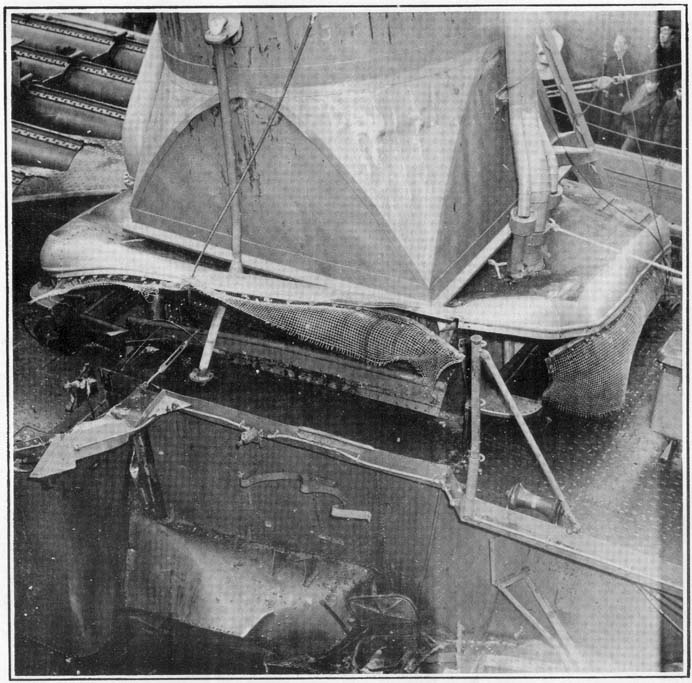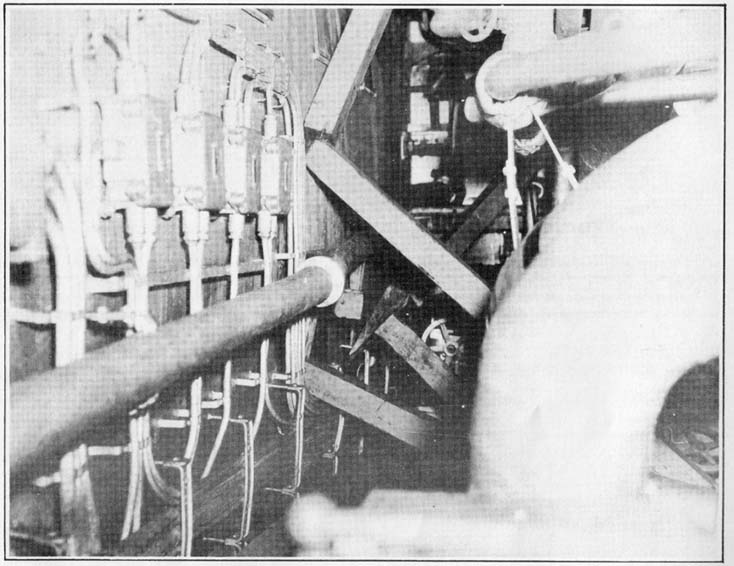
If you can see this text here you should update to a newer web browser
Normal | Highlight & Comment Highlighted Text will be in Yellow, but there are none yet

|
|
U. S. S. K E A R N Y TORPEDO DAMAGE (17 October, 1941) P R E L I M I N A R Y R E P O R T 
|
|
CONTENTS II. SKETCHES III. PHOTOGRAPHS No. 1. General View - Starboard Side No. 2. Close Up - Starboard Side No. 3. Close Up - Starboard Side No. 4. Main Deck Starboard - Looking Down on Damage No. 5. Main and Forecastle Decks - Looking Down No. 6. Main and Forecastle Decks - Looking Down No. 7. Main Deck Looking Forward No. 8. Base of Stack Looking Forward No. 9. Base of Stack and Deck House Looking Aft No. 10. Bridge Deck No. 11. Bulkhead 86-1/2 - Looking Forward
|
|
Supplement Sheet January 15, 1942 Since the printing of this report KEARNY has been inspected by Bureau of Ships representatives and the damage found to be generally as indicated herein. The most important differences are:-
|
|||||||||||||||||||||
|
port stringer plate (See Sketch C). The extent of the structural damage below the waterline cannot be accurately determined from advance information, but the after boundary of principal damage was the main transverse bulkhead at frame 86-1/2 which deflected about one foot but remained tight. This was shored as shown in Photo No. 11, but probably would have held without shoring. Bulkhead 67 was breached, suggesting that shell plating damage extended slightly forward of that point (See Sketch A). The condition of bulkhead 66 is not positively known, but this bulkhead was probably extensively damaged (See paragraph 4). The platform deck between Frames 56 and 66 was probably ruptured on the starboard side in way of the I.C. Room. (Fuel oil and water entered the compartments on the platform deck between these frames but the path of entry is not definitely known.) A light portable plate in passage A-205-L was blown out. LIQUID LOADING BEFORE DAMAGE AND EXTENT OF SUBSEQUENT FLOODING 4. The distribution of fuel oil in the forward tanks was as indicated on Sketch B. Since the ship returned to an even keel immediately after the initial roll induced by the explosion, it is apparent that no appreciable unsymmetrical flooding occurred. A-5-F and A-7-F are reported as "bilged" and A-6-F as "doubtful". Since A-7-F was certainly flooded at once, it must be assumed, in the absence of unsymmetrical flooding, that A-6-F flooded at about the same rate, indicating that the integrity of either bulkhead 66 or the longitudinal bulkheads between these tanks was rather completely destroyed. The extent of flooding directly due to damage was therefore from bulkhead 56 aft to bulkhead 86-1/2. There was no secondary or slow flooding beyond these bulkheads as far as is known, except for some very small leakage around cable stuffing tubes. -2- |
|
5. Had the damage been such that only A-7-F was breached and flooded the ship would have developed a list. Since A-6-F was about 40% full this list would have been small. Since A-5-F, A-6-F and A-7-F are service tanks they will normally be partly filled. If, however, A-5-F and A-7-F had been originally empty and only A-7-F had been flooded the list would probably have been on the order of seven or eight degrees. The condition of tanks B-5-W, B-6-W, B-7-W and B-8-W is not at present known. If they had been empty before damage the ship would have developed a list of probably five to six degrees. UPPER DECKS AND BRIDGES (See Photos 2. 5. 7 and 10) 6. Superstructure around uptakes was partially destroyed and the stack split. The starboard bulwark was carried away from its forward end back to about frame 86-1/2. Forecastle deck was ruptured starboard side over passage A-205-L. Starboard 26 ft. motor whaleboat was destroyed. Bulkheads on starboard and after side of superstructure were wrinkled over stiffeners and decks lifted as shown on Sketch A. Signal bags, 24-inch and 12-inch searchlights and pelorus on starboard wing of bridge were blown overboard. The starboard bridge windshield was carried away and bridge deck torn and lifted as shown on Photo No. 10. Wind screen on bridge blown away, starboard side. The director was trained on the port bow and explosive force dished in rear of director enclosure. MACHINERY PLANT 7. No. 1 fireroom was wrecked and flooded. The superheater was obliterated on No. 1 boiler and the entire boiler forced about four feet to port. Forced draft blowers. 1, 2 and 3 were wrecked and the condition or No. 4 is doubtful. No. 2 boiler was stripped of its casing on the starboard side -3- |
|
and most of the fittings wrecked. Main machinery was operating as a "split-plant" when hit. As a result, No. 2 fireroom and port engine continued in operation, steam was maintained and raised to working pressure in the stand-by boiler in a few minutes. After the explosion the bulkhead stop valve could not be closed until after daylight when the metalsmith crawled beneath the deck and cut away a fouled reach rod with an acetylene torch and was then able to shut off the valve. Until this was completed the starboard engine was run on back pressure and was able to make 85 R.P.M. The ship was thus able to proceed at 10 knots. The starboard engine foundation was deflected but the engine was serviceable. A large portion ofi the steam piping in the forward engine room was somewhat displaced but all piping and valves were capable of operation and only minor leakages were noted. Turbine and bearing clearances were normal. Both main condensers remained tight and showed no abnormal salinity. Fuel oil suction for the after fireroom was from forward tanks. Suction was shifted aft as soon as the extent of damage was ascertained but this resulted in a slug of water putting out fires in No. 2 fireroom until suction from another tank was established. (Based on this experience, the Commanding Officer recommends that when running a split plant, fuel for the boilers be taken from different parts of the ship.) ELECTRICAL AND COMMUNICATIONS 8. Both main generators were in operation furnishing power to their respective main distribution boards. Bus ties between main boards were open. Steering gear power was being taken from the after board. When the starboard synchro-tie cable was shorted the supply breaker for this circuit failed -4- |
|
to trip out, thus tripping the breaker on the main distribution board. The steering power panel then shifted automatically to emergency power, and since the fault had not been cleared, this breaker also tripped out, leaving the steering gear without power. Power was later regained by shifting control to the after conning station. All electric power was cut off temporarily because of electrical fires. As dawn broke, emergency repairs to cables proceeded rapidly and power was restored as quickly as possible. 9. No circuit breakers tripped because of shock. A few failed to open when shorted. The only fuses to be displaced were several knife blade type on the gyro battery charging panel. 10. Main radio was put out of service by concussion and the emergency radio took over. Antennae were fouled by lines and wires. These grounds were cleared immediately. After daybreak emergency repairs to cables proceeded rapidly and emergency phone circuits were rigged. SHOCK EFFECTS 11. No serious shock effects were noted. SHIP CONTROL 12. Both synchro-tie cables to pilot house were put out of action. Steering control was shifted to secondary conning station from which ship was navigated to port, using hand steering control with voice communication from deck. The gyro compass was out of commission. STABILITY 13. The ship did not list. At daybreak the ship was down by the head about four feet. Ammunition and other portable -5- |
|
weights were shifted aft and placed as low in the ship as possible, thus lifting the bow about one foot and improving stability. On entering port the draft forward was 15 feet 8 inches, aft 12 feet 6 inches. CASUALTIES
All deaths and injuries occurred in the vicinity of the explosion. A few of the personnel forward and aft were stunned and shocked. EFFECT ON FIGHTING EFFICIENCY 15. The loss of the plotting room and of electric power to the forward guns resulted in an immediate and serious reduction in battle efficiency. The director was apparently undamaged but lost all power and all telephone communications except with the bridge and guns No. 1 and No. 2. All guns were shifted to local control and could be operated manually, as could the director. The I.C., Action Cut Out and Gunnery switchboard power circuits were inoperative (both normal and emergency power). The main battery could, therefore, have been operated only by hand and in local control. Material damage to guns, mounts and director was apparently negligible, as all guns and hoists gave satisfactory performance when tested on power after arriving in port. Damage to the depth charge, machine gun and torpedo batteries was apparently minor and all could have been used. 16. Reduction in speed restricted the ship's movements drastically. The ship was capable of only limited offensive action but could, apparently, have exercised reasonable defensive effort. -6- |

General View - Starboard Side CONFIDENTIAL |

|

|

|

Main and Forecastle Decks - Looking Down and Forward
|

|

|

Base of Stack and Deck House Looking Aft |

Base of Stack and Deck House Looking Aft |

Bridge Deck |

Bulkhead 86-1/2 - Looking Forward |
INDEX TO FLOODING DIAGRAMS
|
||||||||||||||||||||||
| Damage Sketches; Click to Enlarge | |
|---|---|
|
Sketch A: Outboard Profile showing damage
Sketch B: Overhead Profile at Second Platform (Roughly the waterline)
|
|
SOURCE:
Transcribed by RESEARCHER @ LARGE. Formatting & Comments Copyright R@L.